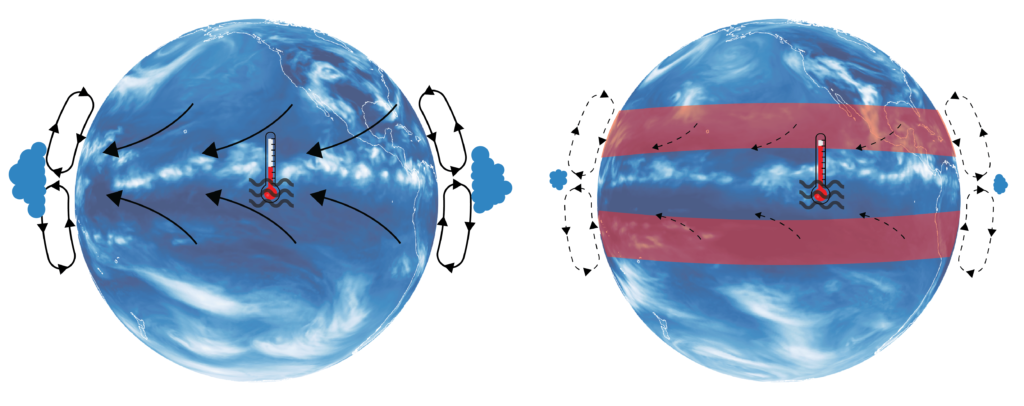In response to future fossil fuel burning, climate computer models simulate a pronounced warming in the tropicaloceans. This warming can influence the El Niño phenomenon and shift weather and rainfall patterns across the globe. Despite being robustly simulated in computer models of the climate system, the origin of this accelerated tropicalwarming has remained a mystery. A new study published this week in the journal Nature Climate Change concludes that climate change outside the tropics is the main culprit.

Earth’s future warming will not be identical everywhere. Atmospheric and oceanic circulation changes, as well as cloud processes, will determine which regions will warm faster and which ones will experience a delayed warming relative to the global mean. Focusing on the tropical regions, a team of scientists from the IBS Center for Climate Physics (ICCP) at Pusan National University in South Korea, along with their international collaborators, has now developed a new method that separates the contributions from local and remote physical processesthat cause warming in a given region.
The team found that the expected future warming in the tropics(15oS-15oN) originates mostly from warming that occurs in subtropicalregions (16oN-32oN and 16oS-32oS). “To understand this surprising phenomenon, one has to understand how different areas interact with each other climatically” says Dr. Malte Stuecker from the ICCP and lead author of the study.
In the subtropical regionsair in the upper atmosphere is sinking, creating high pressure at the surface (seeFigure).At an altitude of about 10-15 km, this sinking motion sucks in tropical air. The resulting large-scale atmospheric circulation is referred to as the Hadley cell and its surface branch, known as trade wind circulation, transports relatively dry subtropical air back to the tropics. Due to the effects of earth’s rotation, trade winds also cause upwelling of cold subsurface waters in the tropicalPacific and Atlantic. “In response to increasing greenhouse gas emissions, future subtropical warming will slow down the atmospheric Hadley cell,” adds Stuecker.This will lead to a weakening of the surface trade winds, less upwelling of cold ocean water,and a resulting warming of the sea surface. In addition, a weaker Hadley cell also means that less humid air is rising, andcloud coverageis reduced in most of the tropics,increasingthe amount of sunlight reaching the surface. “This can further exacerbate future warming in the tropics”, says Axel Timmermann, Director of the ICCP and co-author of the study.
To arrive at these conclusions, the authors used a computer model of the global climate system and ran it for present-day and future CO2conditions. By imposing the extra energy related to the CO2change, either in the tropics or subtropics, the team then found that human-induced subtropicalwarming causesabout40% morefuture tropicalsurface ocean temperature changethan if thesame amount of extra energy would enter Earthʻs atmosphere directly in the tropics.
The study presents a new paradigm to understand the patterns of future global warming and the arising regional differences. “Warming in one area can affect the degree of warming in another place. We are starting to appreciate how strongly different areas are connected in the climate system.” says co-author Prof. Fei-Fei Jin from the University of Hawai’i, USA.
The new Nature Climate Changestudy also points out the possibility that a future reduction of air-pollution in Asian countries may lead to regional warming in the subtropics, which in turn could trigger a warming cascade that might even affect the tropics. However, more research needs to be conducted to quantify the influences of air quality control on climate.
References
Stuecker, M. F., A. Timmermann, F.-F. Jin, C. Proistosescu, S. M. Kang, D. Kim, K.-S. Yun, E.-S. Chung, J.-E. Chu, C. M. Bitz, K. C. Armour, and M. Hayashi: Strong remote control of future equatorial warming by off-equatorial forcing, Nature Climate Change, doi: https://doi.org/10.1038/s41558-019-0667-6
Media Contact
For further information or to request media assistance, please contact: Kyungmi Park, IBS Center for Climate Physics, Pusan National University (+82-51-510-7750, kyungmi@pusan.ac.kr)
About the Institute for Basic Science (IBS)
IBS was founded in 2011 by the government of the Republic of Korea with the sole purpose of driving forward the development of basic science in South Korea. IBS has launched 30 research centers as of January 2019. There are nine physics, two mathematics, six chemistry, seven life science, one earth science, and five interdisciplinary research centers. Go to the IBS website.
About ICCP
The IBS Center for Climate Physics (ICCP) seeks to expand the frontiers of earth system science by conducting cutting edge research into climate dynamics and utilizing high-performance computer simulations, with the goal of improving decadal Earth system forecasts and long-term projections.